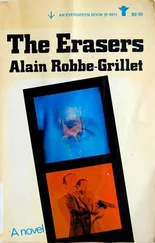He pushed open the door of the café. Three sailors—one almost a boy and two older men—were sitting at a table drinking red wine. Behind the counter the girl with the timorous expression of a dog that had been whipped was leaning against the doorway of the room back of the bar, her wrists behind the small of her back. Mathias passed his hand in front of his eyes.
He asked for a room. Without a word she preceded him step by step up the narrow spiral of the suddenly darkened second staircase, gracefully slipping between the boxes and various utensils that blocked their passage. They reached the landing, the little vestibule, the room with the black and white tiling…. The bed had been made. The bed lamp on the night table was turned on, lighting more brightly the red material at the head of the bed, as well as several tiles, and the lambskin. On the dressing table among the jars and bottles, was the slightly tilted chromium-plated frame holding the photograph. Directly above it, the big oval minor again reflected…. Mathias passed his hand in front of his eves.
The girl had finally understood that he wanted a room as near the harbor as possible for three days. The lodging she suggested, and which he went to see at once, was not in the town proper, but just beyond, a house on the moor near the sea, just beyond the pier. This spot, despite its relative isolation, was nearer the pier than certain sections of the town itself—those, for instance, between the old harbor and the ruins of the fort.
Although of better appearance—cleaner certainly, and more frequently repainted and whitewashed than most the salesman had approached hitherto—the building, obviously the same age as the rest, presented identical physical features, the same simplified architecture: a ground floor with neither upper story nor dormers, and two identical facades, each with two small, almost square windows on either side of a low door. Facing the road—a secondary one which must have been the short cut to the village Mathias had visited before reaching Horses Point—the entrance was embellished with the same holly-leaf mahonias, here perhaps somewhat more flourishing.
Between the doors extended a rectilinear hallway onto which opened all four rooms. Mathias’ was the back one on the left, overlooking the cliff.
The cliff was not very high at this point—lower, in any case, than along the southwest beach or at the two promontories at either end of the island. On the right it fell away toward an indentation in the coast where the sea could be seen, perhaps a third of a mile away.
From the ridge where the face of the cliff began—opposite the house—to the house itself was a distance of no more than three hundred yards of gently rolling moors and a small garden that had been left fallow, although enclosed by barbed-wire attached to wooden fence posts. The whole landscape—low sky, patch of ocean, cliff, garden—was composed of various flat, lusterless, grayish hues.
The window that looked out on it was a yard wide and slightly higher—four panes of the same size with neither curtains nor shade; since it was deeply recessed in the thickness of the wall, the rather large room for which it was the only source of daylight remained virtually in darkness. Only the heavy little table wedged into the recess received enough light for him to write there—add up his accounts there—or draw there.
The rest of the room was in semidarkness. Its appointments further accentuated this defect: a dull-colored carpet and high, heavy pieces of dark furniture. The latter were crowded so close together along all four walls that there was some doubt whether this room was actually intended to be lived in or merely used as a storeroom for all the discarded furniture from the rest of the house. Especially noticeable were three immense cupboards, two side by side opposite the door to the hallway. They filled almost the whole of the rear wall, leaving just enough room for a modest dressing table—this last in the dimmest corner, to the left of the window from which it was separated by two straight chairs standing against the flowered wallpaper. On the other side of the window recess, two other chairs occupied a symmetrical position. But only three of the four chairs were of the same design.
Hence, starting at the window and proceeding left (that is, counter-clockwise), were a chair, another chair, the dressing table (in the corner), a third chair, a cherrywood bed (placed lengthwise against the wall), a tiny pedestal table with a fourth chair in front of it, a commode (in the third corner), the door to the hallway, a kind of drop-leaf table that could be used as a desk when the sides were extended, and finally the third cupboard, standing diagonally across the fourth corner with the fifth and sixth chairs next to it. It was in this last, most imposing, cupboard—which was always locked—that the shoebox which harbored his string collection was kept, on the right-hand side of the lowest shelf.
The girl’s body was discovered the following morning at low tide. Some fishermen—looking for the soft-shelled turtle crabs called “sleepers”—happened to find the body on the rocks under the crossroads.
The salesman heard the news while he was drinking an apéritif at the bar of the café “A l’Espérance.” The sailor who was telling the story seemed quite well informed as to the location, the posture, and the state of the body; but he was not one of the men who had found it, and he did not even say if he had seen it for himself. Furthermore, he seemed completely unmoved by what he was describing. It might as well have been a stuffed doll thrown over the cliff. The man was speaking slowly and with a certain concern for accuracy, furnishing—although sometimes in scarcely logical order—all the necessary material details and offering for each some plausible explanation. Everything was clear, obvious, banal.
Little Jacqueline was lying naked on a bed of brown seaweed among the big, round rocks. Doubtless the movement of the waves had undressed her, for it was unlikely that she had been drowned while swimming—in this weather, and at such a dangerous spot. She must have lost her balance playing at the edge of the cliff, which was very steep at this point. Perhaps she had even tried to reach the water by a more or less passable rock spur which ran down on the left. She must have missed her footing, or slipped, or tried to balance on too weak a point in the rock. She had been killed by the fall—of several yards—her slender neck broken.
The hypothesis that a sudden wave might have swept her off her feet during the rising tide was no more tenable than the supposition that she had drowned while swimming: there was very little water in her lungs—much less, certainly, than if she had drowned. Besides, there were wounds on her head and limbs which corresponded more closely to a ricocheting fall against stone outcroppings than to injuries sustained by a lifeless body tossed about by the sea. Nevertheless—as might be expected—on what remained of her flesh there were also a number of bruises which resembled the result of this kind of contact.
In any case, it was difficult for nonspecialists, even those accustomed to such accidents, to establish with any certitude the origin of the different wounds and abrasions found on the girl’s body; especially since the crabs, or the fish perhaps, had already begun their ravages at certain particularly tender spots. The fisherman thought that the body of an adult would have held out longer against them.
He doubted that a doctor would have anything else to say about the case, which in his opinion was unequivocal. By the same token the salesman learned that there was no doctor on the island and that the man who spoke in such a knowing way had served in the navy as a hospital attendant. There was only an old Civil Guard who as a rule confined himself to making out a death certificate.
Читать дальше












